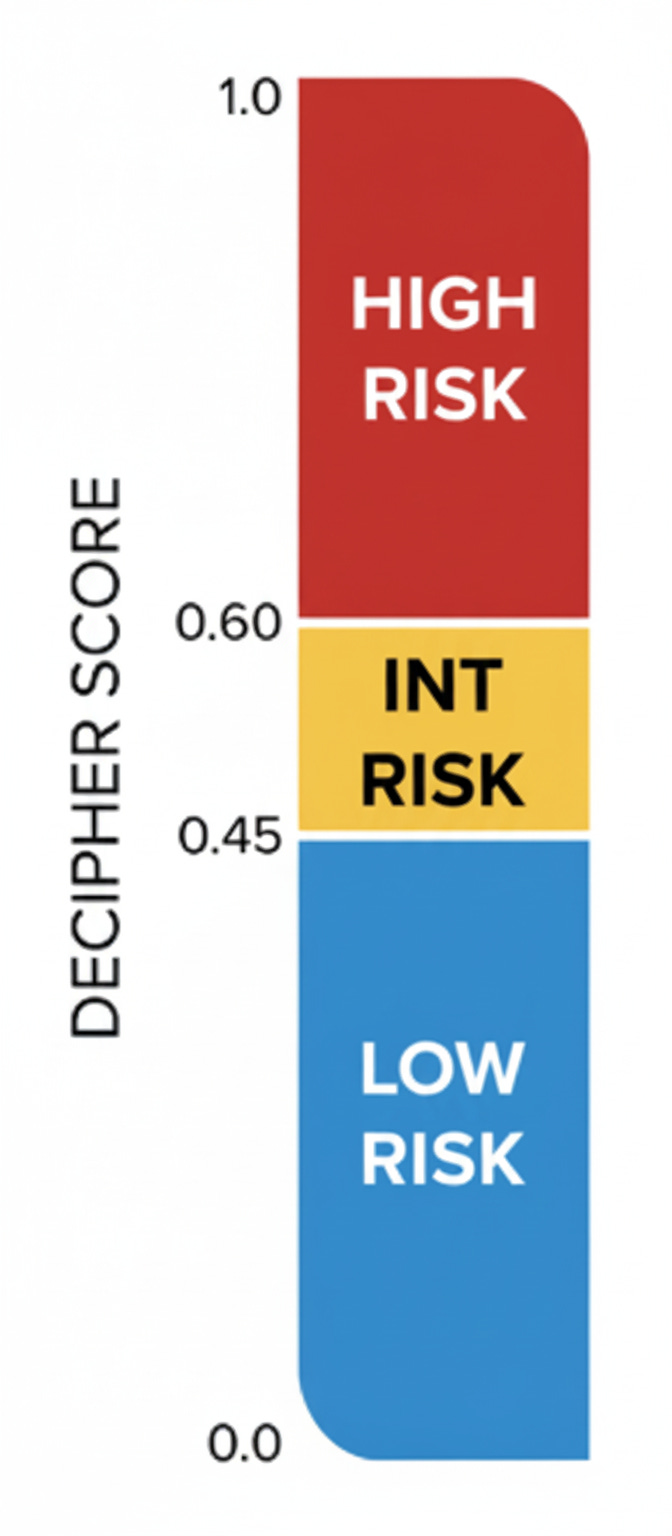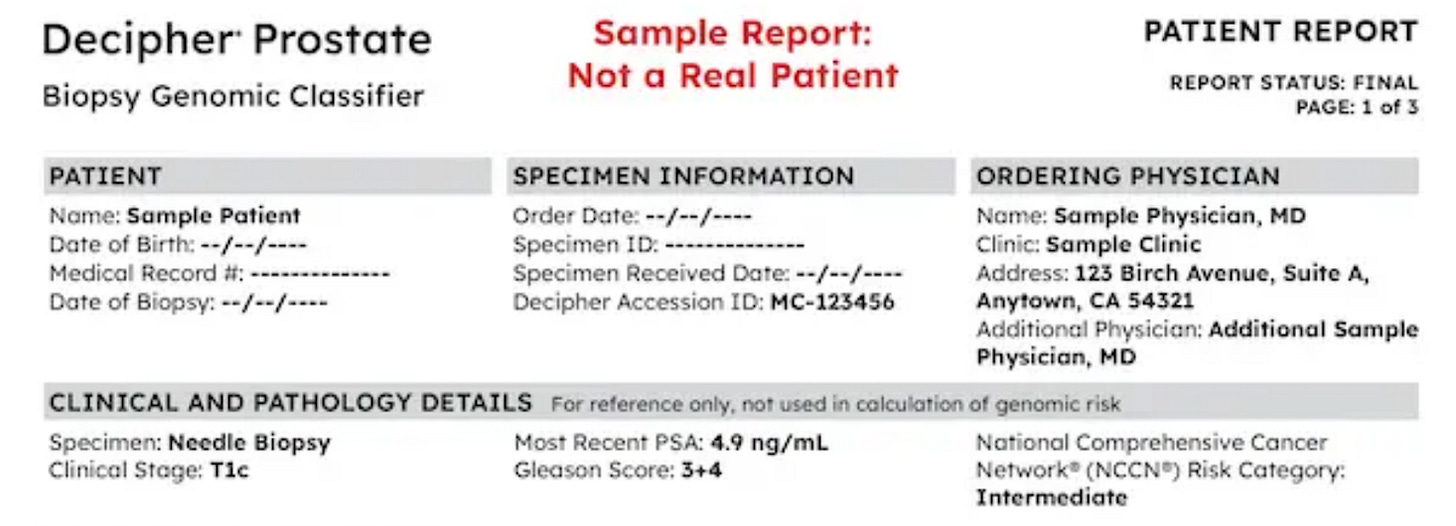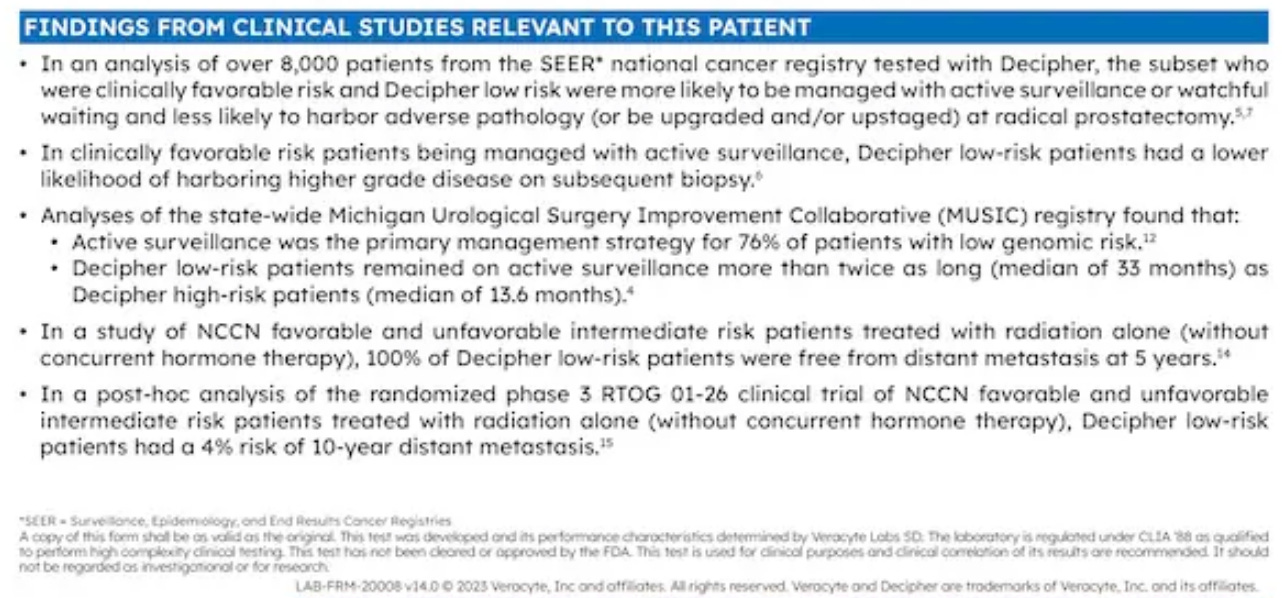Decipher Prostate Biopsy Report Explained - 068
You've received your prostate biopsy results and a Decipher test report filled with scores, graphs, and percentages. It can feel overwhelming.
In this post, I'll walk you through the report section by section to help you understand what it all means.
The test report for the Decipher Prostate Biopsy provides a three-tiered Decipher genomic score reflecting the tumor’s biological risk for distant metastases.
Decipher has been evaluated in multiple clinical trials, including those assessing outcomes during active surveillance and outcomes after definitive treatment.
The accuracy of Decipher has been confirmed through a large amount of high-quality research:
It has been evaluated in over 25 prospective randomized clinical trials.
More than 90 peer-reviewed scientific studies support it.
The research on this test is based on data from over 200,000 patients.
Decipher Prostate Biopsy is for men with localized prostate cancer, whose cancer has not spread outside the prostate. Tissue from a prostate biopsy is submitted for testing to measure the activity level of 22 RNA genes to determine the tumor’s aggressiveness and potential for metastases.
It can help men and their doctors decide if active surveillance is appropriate or if they should undergo active treatment.
This post focuses on understanding the Decipher Prostate Biopsy test report.
Decipher Prostate Biopsy test report
The test report includes the patient's National Comprehensive Cancer Network (NCCN) Risk Category, based on their clinical stage, PSA, and Gleason score; however, it doesn't factor these into the Decipher score.
The NCCN risk category groups patients into statistical risk categories based on clinical and pathological features, including:
Clinical stage
Grade Group
PSA level
Number of positive cores
Percent of cancer in any core
Number of cores with Grade Group 4 or higher.
However, the NCCN risk category does not accurately reflect the tumor’s unique underlying biology.
That’s where Decipher comes in, providing additional information that helps refine and personalize risk assessment within each man’s NCCN risk category (group).
Decipher genomic score and interpretation section
The middle of page 1 of the Decipher Prostate Biopsy test report includes the Decipher genomic score and its interpretation.
The Decipher score risk bar, located on the left, displays the patient’s Decipher score. Although there are three risk groups in the score, the score is continuous. Thus, a score at the higher end of the “High Risk” group reflects a higher risk for metastases than a score at the lower end of the “High Risk” group.
The Decipher risk score reflects the patient’s risk for developing distant metastases.
The interpretation section discusses how the patient’s Decipher risk score and NCCN risk category intersect to form a combined risk assessment.
This combined risk assessment is based on matching the individual’s Decipher score and NCCN risk category with thousands of other men who have the same score and risk category from Phase III clinical trials using the Decipher genomic classifier test. Each clinical trial is cited in the discussion and referenced on page 3 of the report.
The Decipher score value lies in its ability to better stratify risk for metastases within a given NCCN category.
Example: Consider two men who underwent a prostate biopsy and were both classified as "Favorable Intermediate-Risk" by NCCN guidelines.
Man A has a low Decipher score of 0.30.
His genomic risk of metastasis is significantly lower than that of the average man in his NCCN category.
This provides strong evidence to support choosing active surveillance, a path he might have been hesitant to take based on the "intermediate-risk" label.
Man B has a high Decipher score of 0.85.
His score indicates a tumor biology that is significantly more aggressive than his NCCN risk category suggests.
The report will show that his risk of metastasis is much higher than that of his NCCN peers and strongly argues against active surveillance, shifting the focus from active surveillance to definitive treatment.
Risk estimates section
The bottom of page 1 of the report is a section titled “Risk Estimates For This Patient With Standard Therapy For Their Clinical Risk Group.”
This section evaluates risk estimates for patients compared to men within clinical trials with the same Decipher risk score and with the same NCCN risk group who have received definitive treatment, either prostatectomy or radiation therapy to the prostate.
These outcomes include:
5- and 10-year risk of metastasis
15-year risk of death from prostate cancer despite undergoing either treatment
Chance of finding adverse pathology (e.g., finding more aggressive cancer than expected after surgery)
For patients with NCCN low-risk and favorable intermediate-risk prostate cancer, this section displays the chance of finding adverse pathology if they were to undergo a prostatectomy.
This adverse pathology may include the following findings at prostatectomy:
Grade Group 3 (Gleason 4 + 3 = 7) or higher
Stage pT3b (invasion of seminal vesicles) or higher, including lymph node involvement.
Risk graphic and interpretation section
Page 2 of the Decipher Prostate Biopsy Genomic Classifier patient report contains a risk graphic.
This risk graphic demonstrates the patient’s 10-year risk of metastases compared to other men in clinical trials with a similar NCCN risk category and Decipher score.
The graphic also illustrates the frequency of each Decipher risk score (Low, Intermediate, and High) within that group of similar patients. This example shows that 52% of men in that group had a Decipher Low risk score, 22% had a Decipher Intermediate risk score, and 26% had a Decipher High risk score.
The interpretation section displays the patient’s Decipher score percentile ranking in comparison to similar patients in clinical trials. This indicates where your risk falls within that group, helping you understand if your risk is higher, lower, or average compared to others like you.
Findings from clinical studies section
The "Findings From Clinical Studies Relevant To This Patient" section on page 2 provides more detailed information and evidence from Decipher’s database of clinical trials.
It discusses how similar patients have responded to various treatments or what their long-term outcomes have been. This section, based on clinical trials, helps you and your doctor understand potential treatment options by showing scientific observations for patients with the same NCCN risk category and Decipher score.
Page 3 of the Decipher Prostate Biopsy test report
Page 3 of the Decipher Prostate Biopsy patient report includes:
A “Test Description” section.
How the biopsy specimen was prepared for testing.
A description of the Decipher testing technology.
How the risk estimates shown on page 1 were calculated.
The intended use of the test.
Confidence intervals (a range of values that likely contain the true value) of risk estimates shown on page 1.
A reference section of clinical trials from the Decipher database that are cited in this report.
To see a sample report and a video that walks you through it, go to
https://decipherbio.com/decipher-prostate/physicians/biopsy-test-report/
Guideline recommendations
Even though the Decipher Prostate genomic classifier is a suite of three tests, I’ve only detailed the test report for Decipher Prostate Biopsy. That’s because these test reports can be somewhat challenging to understand and should be reviewed with a clinician who is familiar with them.
The guidelines published by the NCCN and the American Urological Association (AUA) concerning active surveillance AS for prostate cancer advise against the routine use of the Decipher test.
The guidelines support its selective use in specific scenarios where the results are likely to alter or influence clinical decision-making.
Decipher is most relevant for refining risk stratification in "gray zone" areas, particularly among men considering AS for low- or favorable intermediate-risk disease. Examples include:
Men with high-volume Grade Group 1 (Gleason 3 + 3 = 6) low-risk disease
Men with Grade Group 1 disease who have an abnormal digital rectal exam (DRE) or high PSA density
Men with low-volume Grade Group 2 (favorable intermediate-risk) disease
In summary, both major guidelines support the use of the Decipher test as a tool to improve prognostic accuracy selectively in men with low- or favorable intermediate-risk prostate cancer who are candidates for active surveillance.
The test may help clinicians and patients make a more informed decision about whether surveillance is safe or if treatment is warranted.
Questions for your doctor:
What does my Decipher score and NCCN risk category mean?
How does my 10-year metastasis risk estimate compare to men like me in the same NCCN risk category?
Are my clinical features - PSA density, % cores, Grade Group, and MRI PI-RADS score - consistent with the findings from the Decipher test?
Do MRI results ever overrule a Decipher score?
How does my Decipher score impact our plan of care?
Conclusion
Ultimately, understanding your Decipher test report is a crucial step in taking control of your health journey and partnering with your doctor to choose the path that is truly right for you.
The Decipher Prostate Biopsy test is a well-validated genomic test that helps improve risk stratification of prostate cancer.
Experts in the clinical management of prostate cancer wish for more prospective studies evaluating Decipher’s long-term impact on patient outcomes, such as quality of life, need for treatment, and overall survival.
As these types of trials show success in these areas, the clinical validation of Decipher will only increase and contribute to a personalized and hopefully more accurate approach to the care of men with prostate cancer.
Genomic scores help identify risk, but they don’t replace the clinical judgment of a qualified clinician, MRI results, or patient preferences.
In the next newsletter, I’ll discuss Decipher GRID, which I believe has immense potential, when properly validated, to elevate prostate cancer management to the next level of personalized care.
Until then, I wish you good health and much love.
Keith








In the interest of education I’m sharing my personal decipher score of 0.95. Based on the findings we threw the proverbial kitchen sink at the cancer. Salvage radiation therapy plus first and second generation ADT. I’ll take a 15% mortality risk.
Hi Keith, as I had initially emailed this rebuttal to HW and it was subsequently posted I would appreciate your feedback ... https://open.substack.com/pub/howardwolinsky/p/in-rebuttal-please-a-patients-contrarian?r=21s6nz&utm_campaign=post&utm_medium=web&showWelcomeOnShare=false
Cordially, Robert